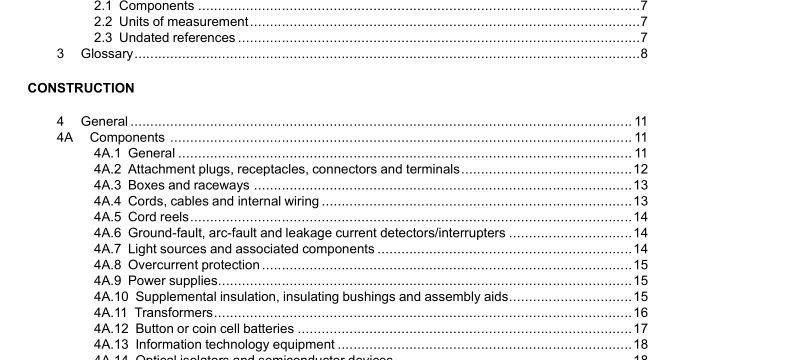UL 867-2021 pdf download.Electrostatic Air Cleaners.
3 Glossary 3.1 For the purposes of this standard the following definitions apply. 3.2 ACCESSIBLE PART – A part located so that it can be contacted by a person either directly or by means of a probe as specified in Accessibility of Uninsulated Live Parts and Moving Parts, Section 7. 3.3 AIR CLEANERS – An air cleaner is defined as one of the following: a) Duct type – An air cleaner intended for installation in and at adjoining ducts, including the plenum, of heating, air conditioning, and ventilating systems. The air cleaner may not be provided with a fan, and the duct may provide part or all of the cabinet. This type of air cleaner may be either cord-and-plug connected or permanently connected to the electrical supply source. b) Fixed type – An air cleaner intended to be: 1) Permanently connected to the electrical supply source; 2) Permanently mounted, such that tools are required for the product installation or removal; or, 3) Sized so that it is not easily moved from one place to another. c) Portable type – A cord-and-plug-connected air cleaner that: 1) Can be easily moved from one place to another for use; and 2) Has no provision for permanent mounting. Tools are not required for the product installation or removal. d) Deleted e) Deleted 3.3.1 BARRIER, INSULATING – A partition for isolating parts of electrical circuits.
3.4.2 CONTROL, OPERATING – A device or assembly of devices, the operation of which starts or regulates the end product during normal operation. For example, a thermostat, the failure of which a thermal cutout/limiter or another layer of protection would mitigate the risk of electric shock, is considered an operating control and in this example could also be called a “regulating control”. Operating controls can also include other controlling devices such as switches, contactors, relays and similar devices. Appendix B specifies control functions that are not considered to result in a risk of fire, electric shock or injury to persons. 3.4.3 CONTROL, PROTECTIVE – A device or assembly of devices, the operation of which is intended to reduce the risk of fire, electric shock or injury to persons during normal and reasonably anticipated abnormal operation of the product. For example, a thermal cutout/limiter, or any other control/circuit relied upon for normal and abnormal conditions, is considered a protective control. Protective controls are also referred to as “limiting controls” or “safety controls” and are investigated under normal and single-fault conditions. Appendix B specifies control functions that are considered to result in a risk of fire, electric shock or injury to persons. 3.4.4 ELECTRONIC COMPONENT – A part in which electrical conduction is achieved principally by electrons moving through a vacuum, gas or semiconductor. A Metal Oxide Varistor (MOV) is considered to be an electronic component, but neon indicators are not. ©IEC. This material is reproduced from IEC 60335-1 Ed. 5.2 b:2016 with permission of the American National Standards Institute (ANSI) on behalf of the International Electrotechnical Commission. All rights reserved.
3.7 HIGH-VOLTAGE CIRCUIT – A circuit involving a potential of more than 600 volts. 3.7.1 IGNITION SOURCE – Any high- or line-voltage electrical component not located within an enclosure. Wiring with VW-1 insulation is not considered an ignition source. 3.8 ISOLATED-LIMITED-ENERGY CIRCUIT – A circuit derived from an isolated-secondary winding of a transformer having a maximum capacity of 100 volt-amperes and an open-circuit-secondary voltage rating not exceeding 600 volts. 3.9 LINE-VOLTAGE CIRCUIT – A circuit involving a potential of not more than 600 volts, and having characteristics in excess of those of a low-voltage or an isolated-limited-energy circuit. 3.10 LOW-VOLTAGE CIRCUIT – A circuit involving a potential of not more than 30 volts rms and supplied by a primary battery, a Class 2 transformer, or by a combination of a transformer and fixed impedance that, as a unit, complies with all the performance requirements for a Class 2 transformer. A circuit derived from a line-voltage circuit by the connection of resistance in series with the supply circuit to limit the voltage and current is not considered to be a low-voltage or an isolated-secondary circuit.UL 867-2021 pdf download.
UL 867-2021 pdf download
